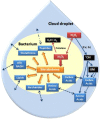Metabolic modulations of Pseudomonas graminis in response to H2O2 in cloud water
- PMID: 31488860
- PMCID: PMC6728378
- DOI: 10.1038/s41598-019-49319-2
Metabolic modulations of Pseudomonas graminis in response to H2O2 in cloud water
Abstract
In cloud water, microorganisms are exposed to very strong stresses especially related to the presence of reactive oxygen species including H2O2 and radicals, which are the driving force of cloud chemistry. In order to understand how the bacterium Pseudomonas graminis isolated from cloud water respond to this oxidative stress, it was incubated in microcosms containing a synthetic solution of cloud water in the presence or in the absence of H2O2. P. graminis metabolome was examined by LC-MS and NMR after 50 min and after 24 hours of incubation. After 50 min, the cells were metabolizing H2O2 while this compound was still present in the medium, and it was completely biodegraded after 24 hours. Cells exposed to H2O2 had a distinct metabolome as compared to unexposed cells, revealing modulations of certain metabolic pathways in response to oxidative stress. These data indicated that the regulations observed mainly involved carbohydrate, glutathione, energy, lipid, peptides and amino-acids metabolisms. When cells had detoxified H2O2 from the medium, their metabolome was not distinguishable anymore from unexposed cells, highlighting the capacity of resilience of this bacterium. This work illustrates the interactions existing between the cloud microbial metabolome and cloud chemistry.
Conflict of interest statement
The authors declare no competing interests.
Figures







References
-
- Deguillaume L, et al. Classification of clouds sampled at the puy de Dôme (France) based on 10 yr of monitoring of their physicochemical properties. Atmos. Chem. Phys. 2014;14:1485–1506. doi: 10.5194/acp-14-1485-2014. - DOI
-
- Vione D, Maurino V, Minero C, Pelizzetti E. The atmospheric chemistry of hydrogen peroxide: a review. Ann. Chim-Rome. 2003;93:477–488. - PubMed
-
- Herckes P, Valsaraj KT, Collett JL. A review of observations of organic matter in fogs and clouds: Origin, processing and fate. Atmos. Res. 2013;132–133:434–449. doi: 10.1016/j.atmosres.2013.06.005. - DOI
Publication types
MeSH terms
Substances
Supplementary concepts
LinkOut - more resources
Full Text Sources

